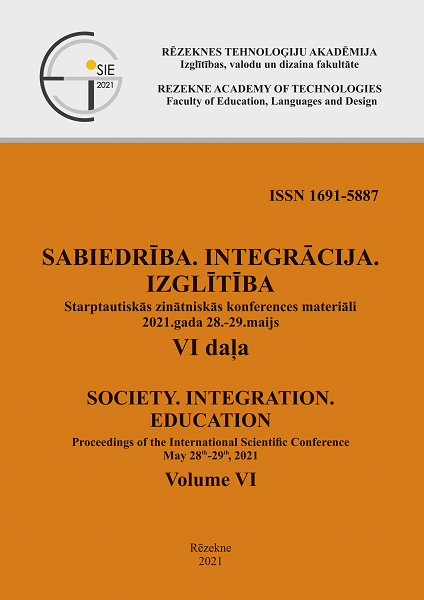ATTRACTIVENESS OF THE EASTERN AUKŠTAITIJA REGION FOR LOCAL TOURISM UNDER COVID-19 CONDITIONS
DOI:
https://doi.org/10.17770/sie2021vol6.6325Keywords:
attractiveness of the region, Eastern Aukštaitija region, local tourismAbstract
The article discusses the attractiveness factors of the Eastern Aukštaitija region for local tourism under COVID - 19 conditions and presents the results of the research (analysis of scientific literature, questionnaire surveys and analysis of strategic documents). The aim of the research is to perform an analysis of the attractiveness of the Eastern Aukštaitija region for local tourism under COVID-19 conditions. Objectives of the research: to describe the factors of tourism region's attractiveness for local tourism; to perform an analysis of the attractiveness of the Eastern Aukštaitija region for local tourism under COVID-19 conditions. An analysis of the scientific literature showed that destination attractions define the framework within which visitors enjoy their vacations. They include all forms of natural and created (manmade) resources, culture, heritage, history, customs, architectural features, traditional artwork, cuisine, music and handicrafts that attract travellers. According to the results of the research, the choice of travels in the Eastern Aukštaitija region is mostly influenced by such factors of attractiveness of the region as natural resources, cultural resources and interesting places of interest, as well as attractiveness of the tourism destination/ region.
Downloads
References
Andrulienė, R., Armaitienė, A., Povilanskas, R., Janulienė, R., & Dulskis, D. (2011). Study of Lithuanian Tourism Potential Assessment in Determining the Maximum Tourist Attraction Areas and Priorities for Their Uses. Vilnius.
Berardi, S. (2002). Development of tourism. Milano.
Crouch, G., & Ritchie, B. (1999). Tourism, competitiveness, and societal prosperity. Journal of Business Research, 44, 137–152.
Dwyer, L., Livaic, Z., & Mellor, R. (2003). Competitiveness of Australia as a tourist destination. Journal of Hospitality and Tourism Management, 10(1), 60–78.
Enright, M., J., and Newton, J. (2005) Determinants of Tourism Destination Competitiveness in Asia Pacific: Comprehensiveness and Universality. Journal of Travel Research, Vol. 4, 1-12.
Falk, R. (2002). Communication: Means and ends in the struggle against global terrorism. Pacific Review, 14(1), 49-65.
Formica, S. (2002). Measuring destination attractiveness: A proposed framework. Journal of American Academy of Business, 1(2), 350–355.
Garau-Taberner J. (2007). Measuring destination competitiveness: an exploratory study of the Canaries, Mainland Spain, France, the Balearics and Italy. Tourism today, No. 7, 61–78.
Gartner, W. (1989). Tourism image: Attribute measurement of state tourism products using multidimensional scaling techniques. Journal of Travel Research, 28(2), 16–20.
Goeldner, Ch. R., & Ritchie J. R. B. (2006). Tourism. Principles, Practices, Philosophies. John Willey & Sons, INC, 577.
Haahti, A. (1986). Finland’s competitive position as a destination. Annals of Tourism Research, 13, 11–35.
Hu, Y., & Ritchie, B. (1993). Measuring destination attractiveness: A contextual approach. Journal of Travel Research, 25–34.
Labanauskaitė, D., (2020). International Tourism Development and Economic Evaluation. Monograph. Klaipeda: Klaipeda University Publishing House.
Labanauskaitė, D., & Jonuškienė, E. (2015). Assessment of changes in Lithuanian tourism attractiveness. Professional studies: theory and practice, 15, 98-103.
Labanauskaitė, D., & Gedvilas, E. (2014). Lithuanian tourism competitiveness in the context of Baltic countries. Regional Formation and Development Studies, No. 2(10)
Klenosky, D. (2002). The “pull” of tourism destinations: A means–end investigation. Journal of Travel Research, 40, 385–395.
Law on Tourism of the Republic of Lithuania. (2021). No. XIII-310, version in force from 01.01.2021.
Lithuanian Tourism Development programme for 2014-2020. (2013). Retrieved from https://mita.lrv.lt/uploads/mita/documents/files/_en/national-programmes/innovation-in-lithuania/lithuanian_innovation_programme.pdf
Lew, A. (1987). A framework of tourist attraction research. Annals of Tourism Research, 14(4), 553–575.
Leiper, N. (1990). Tourist attraction systems. Annals of Tourism Research, 17, 367–384
Malinauskaitė, V. (2017). Management of international tourism development is based on assessments of the region's attractiveness. Doctoral dissertation. Vilnius: VGTU.
Mayo, E., & Jarvis, L. (1981). Psychology of leisure travel. Boston: CABI Publishing.
Middleton, V. (1989). Tourist product. In; F. S. Witt & L. Moutinho (Eds.), Tourism marketing and management handbook. London: Prentice Hall.
Prideaux, B. (2000b). The resort development spectrum—a new approach to modelling resort development. Tourism Management, 21, 225–240.
Utena region development in 2014-2020 plan. (2014). Retrieved from: https://lietuvosregionai.lt/lt/8/utenos-regiono-pletros-2014-2020-metams-planas-273.html
United Nations World Tourism Organization. (2020). Retrieved from: https://www.unwto.org/
Vengesayj, S., & Mavondo, F. (2009). Tourism destination attractiveness: Attractions, Facilities and People as Prediction. Tourism Analysis. DOI: 10.3727/108354209X12597959359211, Retrieved from: https://www.researchgate.net/publication/233643032


